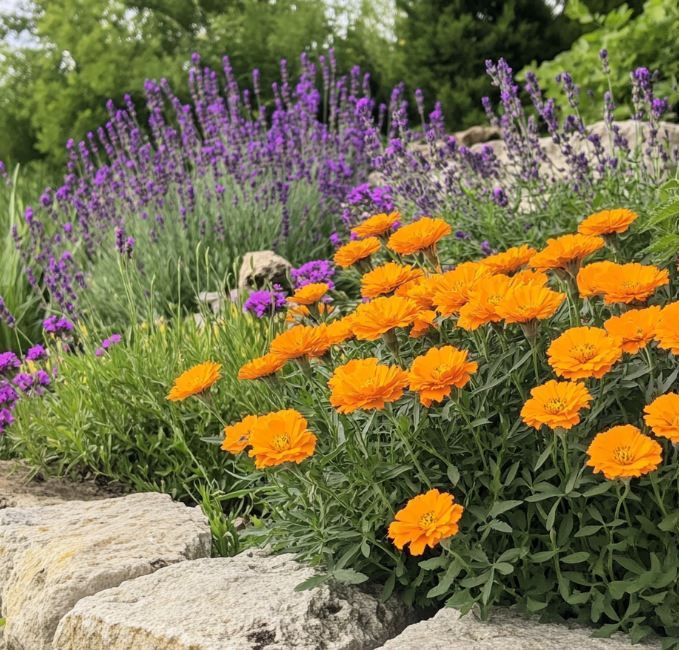In the endless struggle to maintain a healthy garden, pests can often feel like the ultimate challenge. While traditional pesticides offer a quick fix, they also come with environmental concerns and the risk of harming beneficial insects. What if there were a way to combat pests while keeping your garden eco-friendly, vibrant, and fragrant?
Enter insect-repellent plants—a natural solution that combines functionality with beauty. These seven plants not only deter pests but also elevate the aesthetic appeal of your garden. Let’s explore these green defenders and how they can help transform your outdoor space into a sanctuary for plants and pollinators alike.
1. Lavender (Lavandula)
Lavender is a gardener’s favorite, celebrated for its soothing fragrance and stunning purple blooms. While humans adore its scent, pests like moths, fleas, mosquitoes, and flies steer clear of it.
- How to Use: Plant lavender along pathways, garden borders, or in pots near windows and doors to create a natural pest barrier.
- Extra Benefits: Lavender attracts pollinators like bees and butterflies, making it a win-win for your garden.
2. Marigolds (Tagetes)
Bright and cheerful, marigolds are as practical as they are beautiful. Their strong aroma repels aphids, mosquitoes, and nematodes.
- How to Use: Surround vegetable beds with marigolds to protect crops from pest infestations.
- Extra Benefits: These hardy flowers invite beneficial insects like ladybugs, which prey on harmful pests.
3. Basil (Ocimum basilicum)
This culinary herb isn’t just for your kitchen—it’s a potent insect repellent as well! The robust aroma of basil keeps flies and mosquitoes at bay.
- How to Use: Plant basil in pots on patios, balconies, or near outdoor seating areas.
- Extra Benefits: Harvest fresh leaves for cooking while enjoying a pest-free dining experience outdoors.
4. Mint (Mentha)
Mint’s refreshing scent is its secret weapon against pests like ants, mosquitoes, and flies. However, this versatile herb requires careful management.
- How to Use: Grow mint in containers or confined spaces to prevent its invasive spread.
- Extra Benefits: Use fresh mint for teas, desserts, or savory dishes right from your garden.
5. Rosemary (Rosmarinus officinalis)
Known for its woodsy fragrance and culinary versatility, rosemary also serves as a natural deterrent for mosquitoes and cabbage moths.
- How to Use: Plant rosemary near garden beds, pathways, or outdoor dining areas.
- Extra Benefits: This hardy herb thrives in dry conditions and adds depth to roasted dishes and marinades.
6. Chrysanthemums (Chrysanthemum morifolium)
These vibrant flowers contain pyrethrum, a natural insecticide that repels ants, roaches, ticks, fleas, and bedbugs.
- How to Use: Incorporate chrysanthemums into garden beds or place potted varieties around your home.
- Extra Benefits: Their vivid colors bring life to your garden while offering protection from common pests.
7. Lemongrass (Cymbopogon citratus)
Lemongrass is not only an elegant plant but also a powerful mosquito repellent thanks to its refreshing citrus aroma.
- How to Use: Use lemongrass as a border plant or in pots near patios.
- Extra Benefits: The stalks can be harvested for use in cooking, teas, and essential oils.
Why Choose Insect-Repellent Plants? 🌺
Incorporating these plants into your garden offers several advantages:
- Eco-Friendly Pest Control: Reduces the need for harmful chemical pesticides.
- Aesthetic Appeal: Adds color, texture, and fragrance to your outdoor space.
- Multipurpose Benefits: Many of these plants are edible or attract beneficial insects.
Final Thoughts: A Garden That Thrives Naturally 🌿
By planting these seven insect-repellent beauties, you can achieve a lush, vibrant garden that thrives without the use of chemical pesticides. From the calming scent of lavender to the zesty charm of lemongrass, these plants provide both protection and personality.
🌟 Transform your garden into a pest-free paradise and enjoy the rewards of sustainable, natural gardening. Happy planting! 🌟




